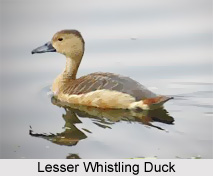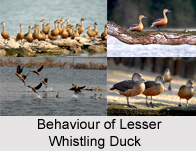 Lesser Whistling Duck bears a scientific name "Dendrocygna javanica", also known as Indian whistling duck or lesser whistling teal, is a species of whistling duck that breeds in the Indian Subcontinent and Southeast Asia.
Lesser Whistling Duck bears a scientific name "Dendrocygna javanica", also known as Indian whistling duck or lesser whistling teal, is a species of whistling duck that breeds in the Indian Subcontinent and Southeast Asia.
Concentration of Lesser Whistling Duck
Lesser whistling ducks are nocturnal feeders and during the day may be found in flocks around lakes and wet paddy fields. They can perch on trees and sometimes build their nest in the hollow of a tree. This brown and long-necked duck has broad wings that are visible in flight and produces a loud two-note wheezy call. It has a chestnut rump, differentiating it from its larger relative, the fulvous whistling duck, which has a creamy white rump. There are large numbers of Lesser Whistling Ducks that are sometimes found in urban wetlands such as in Kolkata and Goa, particularly during winter. In the Alipore Zoological gardens, captive individuals were introduced in the 1930s and wild birds joined this nucleus subsequently.
Structure of Lesser Whistling Duck
 Lesser Whistling Duck is like chestnut brown duck that is confusable only with the fulvous whistling duck but has chestnut upper-tail coverts unlike the creamy white in the latter. When flying straight, their head is held below the level of the body as in other Dendrocygna species. The crown appears dark and the sexes are alike in plumage. They fly slowly but with rapid wing-flapping and usually producing a repetitive wheezy seasick call as they circle overhead. They are very nocturnal and often rest during the day. The outermost primary feather has the inner vane modified. This has been said to aid in producing a whistling sound in flight, although this has not been supported by field studies.
Lesser Whistling Duck is like chestnut brown duck that is confusable only with the fulvous whistling duck but has chestnut upper-tail coverts unlike the creamy white in the latter. When flying straight, their head is held below the level of the body as in other Dendrocygna species. The crown appears dark and the sexes are alike in plumage. They fly slowly but with rapid wing-flapping and usually producing a repetitive wheezy seasick call as they circle overhead. They are very nocturnal and often rest during the day. The outermost primary feather has the inner vane modified. This has been said to aid in producing a whistling sound in flight, although this has not been supported by field studies.
Distribution of Lesser whistling Duck
This is a largely resident species distributed widely across lowland wetlands of the Indian Subcontinent and Southeast Asia. The species ranges across India, Nepal, Sri Lanka, Malaysia, Singapore, Indonesia, Myanmar, Thailand and Vietnam. They also occur on islands in the region including the Andaman and Nicobar Islands and Maldives.
Weather Expression of Lesser Whistling Duck
Lesser whistling ducks sometimes make local movements in response to weather and changes in water availability and the more northern birds winter further south. They are found in freshwater wetlands with good vegetation cover and often rest during the day on the banks or even on the open sea in coastal areas. Downy chicks are black with a white eyebrow and white patches on the back of the head, the wing, lower back and rump. Albino individuals have been seen in the wild.











